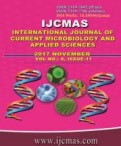


 National Academy of Agricultural Sciences (NAAS)
National Academy of Agricultural Sciences (NAAS)

|
PRINT ISSN : 2319-7692
Online ISSN : 2319-7706 Issues : 12 per year Publisher : Excellent Publishers Email : editorijcmas@gmail.com / submit@ijcmas.com Editor-in-chief: Dr.M.Prakash Index Copernicus ICV 2018: 95.39 NAAS RATING 2020: 5.38 |
A field experiment was conducted during the rainy (kharif) seasons of 2011 and 2012 at Imphal, Manipur to study the performance of hybrid rice (Oryza sativa L.) “PAC 801” to planting times and nitrogen levels on the production potential, nutrient uptake and nitrogen use efficiency under rainfed shallow land condition in a split plot design with three replications, consisting of 12 treatments, namely, main plots: three dates of transplanting (July 6, July 21 and August 5) and sub-plots: four levels of nitrogen (0, 60,120 and 160 kg N ha-1). The research results indicated that 21 July transplanted hybrid rice produced significantly higher yield, yield attributes and N, P and K uptake of grain and straw. The delayed planting on 5 August significantly reduced these crop parameters. The reduction in grain yield to extent of 12 per cent and a loss of 28 kg grain/ha/day was observed under 5 August planting. Planting either on 6 July or 21 July recorded significantly higher Agronomic Efficiency of Nitrogen (AEN) and Partial Factor Productivity (PFPN) than late planting on 5 August. On the contrary, the lowest Nitrogen Harvest Index (NHI) was recorded from crop planted on 21 July. Nitrogen fertilization resulted in significant increase in yield, yield attributes viz. number of panicles m-2, panicle length, number of spikelets panicle-1, number of filled grains panicle-1, percentage of filled grains and test weight and grain and straw N, P and K uptake of hybrid rice with every increase in dose of nitrogen upto 180 kg N ha-1. Application of 180 kg ha-1 increased the grain yield of hybrid rice to the extent of 2.20, 13.30 and 32.78 per cent over 120, 60 and 0 (control) kg ha-1 nitrogen levels respectively while the nitrogen fertilization beyond 60 kg N ha-1 level significantly reduced the agronomic efficiency, partial factor productivity and apparent recovery of nitrogen on hybrid rice. Nitrogen application also significantly decreased the nitrogen harvest index with increasing levels. Transplanting hybrid rice on 21st July along with nitrogen fertilization of 120 kg ha-1 resulted to the maximization of net return and B: C ratio.
 |
 |
 |
 |
 |